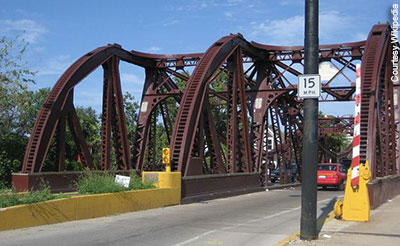Cortland Street Drawbridge
41 55 01.1 N, 87 39 51.4 W

The Cortland Street Drawbridge, a trunnion-bascule highway bridge, was the first of its kind and became the model for this type of urban transportation structure.
In 1899, engineers from the City of Chicago's Division of Bridges and Viaducts performed a survey of moveable bridge design in the U.S. and Europe. Their study led to the conclusion that the unusual trunnion bascule design would best meet their needs.
The Cortland Street Drawbridge was the first trunnion bascule bridge constructed in the United States. In operation longer than any bascule bridge of its kind, it was a model for 53 of Chicago's 54 moveable bridges. Although no longer in use, the bridge stands as a symbol of the pioneering engineering efforts that led to modern-day bascule bridge design.
Facts
- The bridge leaves are supported at the shore end on a trunnion, or shaft.
- When the bridge opens, the leaves raise by rotating about the trunnion to a nearly vertical position.
- When the bridge is open or opening, the trunnion supports the entire dead weight of the leaf.
- The river arm, extending from the trunnions over the water, is longer than the portion extending to the rear of the trunnions. This required a counterweight at the rear of the bridge to balance the weight.
- The bridge is raised or lowered by the operation of a rack attached to the rear of each truss. The pinions which engage the racks are operated by electric motors and other machinery which are housed in a nearby facility.
- The term "bascule" is French for "teeter-totter," a concept that depends on weights at both ends of a beam supported on a fulcrum. In this case, a leaf and a counter weight comprise the two ends of the beam and the trunnion comprises the fulcrum.

